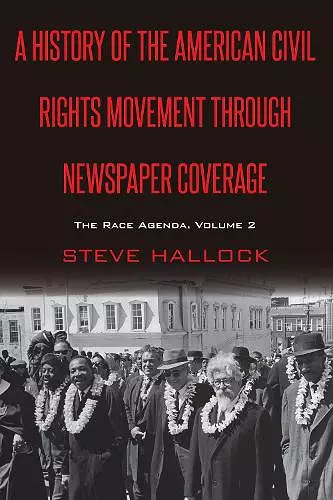A History of the American Civil Rights Movement Through Newspaper Coverage
The Race Agenda, Volume 2
Steve Hallock author David Copeland editor
Format:Hardback
Publisher:Peter Lang Publishing Inc
Published:13th Feb '20
Currently unavailable, and unfortunately no date known when it will be back

As the first volume of this two-part study established, major newspapers across the United States used framing and gatekeeping to shape the narratives of the tumultuous civil rights movement. Beginning with the landmark 1954 U.S. Supreme Court Brown v. Board of Education decision and the subsequent battle over desegregating a Little Rock high school, and continuing through the 1960 lunch-counter sit-ins, the next year’s freedom rides, and the 1963 Birmingham demonstrations, these newspapers helped set the agenda in their reportage of the movement. This second volume opens with the deadly September 1963 terrorist bombing of an African-American church in Birmingham, which crushed the euphoria that civil-rights crusaders had experienced after the 1963 March on Washington. What followed—including the mob violence and police brutality at Selma, the migration of race riots northward and westward, the rise of the Black Panther Party, and the assassination of Martin Luther King, Jr.—confirms the findings of the first volume. Major newspapers, in their coverage, painted starkly differing versions of the same incidents and events. The book contrasts a Northern and Western press more sympathetic to the civil rights crusade with Southern newspapers that depicted a South victimized by violent outside agitators bent on tearing down Southern culture and norms. Amid the current volatile climate of our politics, this study underscores the power of language in constructing our immediate and distant reality.
“Steve Hallock’s book is a very readable blend of theory and good, old-fashioned story-telling. The author looks at some dozen major papers in all regions of the country, and through them brings to life some ten or so key moments in the civil rights movement. Doing so lets the reader go well beyond such usual sources as The New York Times and The Washington Post, and ponder regional and political patterns in the way the nation’s press framed coverage of this key period in American history.”—Laurence Glasco, Professor of History and Director of the University of Pittsburgh Center on Race and Social Problems
“Steve Hallock’s second volume of his study of newspaper coverage of the civil rights era continues to represent a giant leap in our understanding of how the press covered that period. Far more in-depth than what other historians have written, this book disposes of the myth of the northern and southern newspapers being monolithic, with each part of the country framing the story differently and using agenda setting to subtly put their slant on the events that occurred. In fact, different papers in the same part of the country did not always operate in the same fashion. And importantly, Hallock also shows how western papers had their own mediated reality of the era, too. All of this results in an important book that will be a must read for future researchers of the press and the civil rights era.”—Patrick S. Washburn, Professor Emeritus at the E.W. Scripps School of Journalism at Ohio University and author of A Question of Sedition: The Federal Government’s Investigation of the Black Press during World War II (1986) and The African American Newspaper: Voice of Freedom (2006)
“This book’s study of framing and its consequences … offers insights into the practice of American journalism of the past while offering us a lens through which to understand today’s rapidly shifting political and journalistic landscape. It is an important book arriving at a critical time.”—From the Foreword by David R. Davies, Professor of Journalism in School of Communication at the University of Southern Mississippi and author of The Press and Race: Mississippi Journalists Confront the Movement (2001) and The Postwar Decline of American Newspapers (2006)
ISBN: 9781433153976
Dimensions: unknown
Weight: 781g
494 pages
New edition